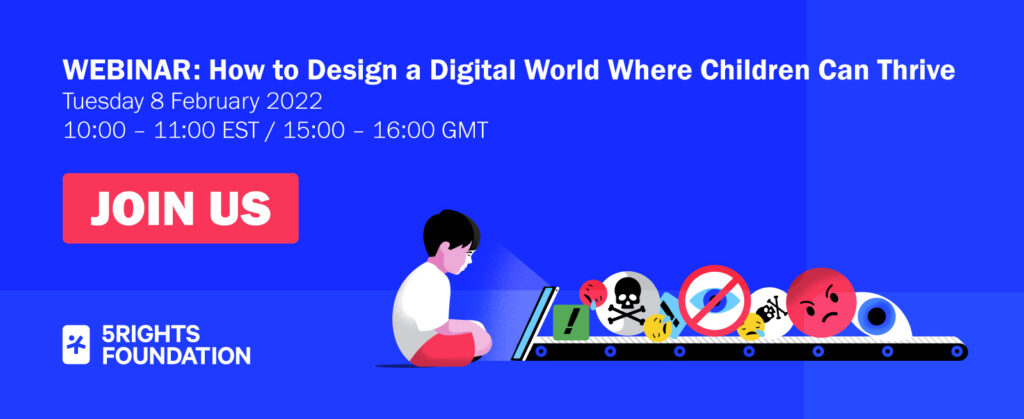2021 set off alarm bells for big tech when the courageous whistle-blowers Frances Haugen, Sophie Zhang, and Nobel Prize winner Maria Ressa made front-page news of irresponsible design of technology – an issue that’s also demonstrated by 5Right’s extensive research.
The digital world is entirely human-made: designers, engineers, and rule-makers can imagine and design the digital world so that children are protected from harm and their rights are upheld. A pioneering new standard shows how.
Many policymakers, civil society organizations, and companies want to bring about a digital world that is designed with children in mind, but until now there has been no guidance as to how, or where to start. So, two years ago, 5Rights and the Institute of Electrical and Electronics Engineers Standards Association (IEEE SA), set out to address this gap.
In collaboration, we developed the pioneering IEEE 2089-2021 Standard for Age Appropriate Digital Service Framework, published in November 2021. This represents an important milestone as it introduces a series of processes that companies can follow to put young people’s needs at the heart of the design of digital products and services. Supporting global efforts of regulators and organizations seeking to ensure that young people are catered for in the digital world, this practical tool will help deliver age-appropriate design.
As summarised by 5Rights Founder and Chair, Baroness Kidron, “For many years we have asked how to design digital services for children – the IEEE 2089-2021 Standard answers that question.” Now it is not just necessary to make online services fit for children, it is technically feasible. No more excuses.
 Join us at our webinar event
Please join us on 8 February 2022 at 10:00 EST / 15:00 GMT by registering here, to hear how to design a digital world where children can thrive.
The panel of experts will discuss the creation of the Standard, the gap it addresses, and how it will work in practice. Our Chair, Baroness Beeban Kidron OBE – who will introduce and chair the session – will be joined by:
Join us at our webinar event
Please join us on 8 February 2022 at 10:00 EST / 15:00 GMT by registering here, to hear how to design a digital world where children can thrive.
The panel of experts will discuss the creation of the Standard, the gap it addresses, and how it will work in practice. Our Chair, Baroness Beeban Kidron OBE – who will introduce and chair the session – will be joined by:
 Nick Martlew is the Executive Director of 5Rights. He has over fifteen years of experience in policy development, campaigns, and leadership. He helped set up and run Digital Action, and was Crisis Action’s UK Director, Security Lead, and lead author on Creative Coalitions, a handbook for collective campaigns. Nick has previously worked with Oxfam and Save the Children in the Democratic Republic of Congo, Ethiopia, the Middle East, and the UK.
Nick Martlew is the Executive Director of 5Rights. He has over fifteen years of experience in policy development, campaigns, and leadership. He helped set up and run Digital Action, and was Crisis Action’s UK Director, Security Lead, and lead author on Creative Coalitions, a handbook for collective campaigns. Nick has previously worked with Oxfam and Save the Children in the Democratic Republic of Congo, Ethiopia, the Middle East, and the UK.
What does the Standard actually do?
The Standard introduces practical steps that companies can follow in the life cycle of product design to ensure their products and services are age-appropriate. Key areas of the Standard include:- Recognizing child users
- Meeting children’s diverse needs
- Upholding children’s rights
- Offering fair terms of service
- Presenting information in an age-appropriate way
- Making the best interests of the child a primary consideration in design decisions
How was the Standard developed?
The IEEE 2089-2021 Standard was developed by a cross-disciplinary group of experts from across the globe – including from the worlds of telecoms, AI, computer science, and legislation. They all had one thing in common: they were united by the desire to ensure that the digital world is designed with young people in mind. The Standard was developed over two years and has undergone peer review by the IEEE community. It was published in November 2021.How you can use the Standard
5Rights owes our grateful thanks to IEEE for making the 2089-21 Standard available free of charge. This means that any organization or business can use the framework to design age-appropriate services for children, ushering forth a new era of tech responsibility in which children’s best interests are designed into products by default. We urge all companies to adopt the 2089-2021 Standard and welcome you to contact us with any comments and experiences you have in using it. Download IEEE 2089-2021 Standard for Age Appropriate Digital Service Framework PDF Join us at our webinar event
Please join us on 8 February 2022 at 10:00 EST / 15:00 GMT by registering here, to hear how to design a digital world where children can thrive.
The panel of experts will discuss the creation of the Standard, the gap it addresses, and how it will work in practice. Our Chair, Baroness Beeban Kidron OBE – who will introduce and chair the session – will be joined by:
Join us at our webinar event
Please join us on 8 February 2022 at 10:00 EST / 15:00 GMT by registering here, to hear how to design a digital world where children can thrive.
The panel of experts will discuss the creation of the Standard, the gap it addresses, and how it will work in practice. Our Chair, Baroness Beeban Kidron OBE – who will introduce and chair the session – will be joined by:
- Konstantinos Karachalios, Managing Director at IEEE SA.
- Professor Katina Michael, Arizona State University, Chair of the 2089-2021 Standard Working Group.
- Ansgar Koene, Global AI Ethics and Regulatory Leader at EY, and Senior Research Fellow at the University of Nottingham. Member of the 2089-2021 Standard Working Group.
 Nick Martlew is the Executive Director of 5Rights. He has over fifteen years of experience in policy development, campaigns, and leadership. He helped set up and run Digital Action, and was Crisis Action’s UK Director, Security Lead, and lead author on Creative Coalitions, a handbook for collective campaigns. Nick has previously worked with Oxfam and Save the Children in the Democratic Republic of Congo, Ethiopia, the Middle East, and the UK.
Nick Martlew is the Executive Director of 5Rights. He has over fifteen years of experience in policy development, campaigns, and leadership. He helped set up and run Digital Action, and was Crisis Action’s UK Director, Security Lead, and lead author on Creative Coalitions, a handbook for collective campaigns. Nick has previously worked with Oxfam and Save the Children in the Democratic Republic of Congo, Ethiopia, the Middle East, and the UK.